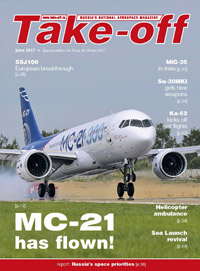|
 The Samara Kuznetsov JSC, a subsidiary of the United Engine Corporation (UEC), known for its powerful engines mounted by long-range bombers, is running pilot work on an advanced turbofan with a thrust of 30 tf for airliners and freighters, designated as PD-30. In the future, such an engine could power future passenger and cargo planes, being developed under the Aircraft 2020 programme, and the upgraded Antonov An-124-300 Ruslan heavylifter as well. The Samara Kuznetsov JSC, a subsidiary of the United Engine Corporation (UEC), known for its powerful engines mounted by long-range bombers, is running pilot work on an advanced turbofan with a thrust of 30 tf for airliners and freighters, designated as PD-30. In the future, such an engine could power future passenger and cargo planes, being developed under the Aircraft 2020 programme, and the upgraded Antonov An-124-300 Ruslan heavylifter as well.
|
|
 The Russia’s United Engine Corporation (UEC) is increasing its aircraft engine output. In 2011, UEC’s subsidiaries manufactured about 650 engines for planes and helicopters. UEC General Designer Alexander Ivakh mentioned this at the 12th Engines international salon in Moscow in April 2012. “Overall, 230 helicopter engines and about 420 plane engines were manufactured and sold last year”, he said. The Russia’s United Engine Corporation (UEC) is increasing its aircraft engine output. In 2011, UEC’s subsidiaries manufactured about 650 engines for planes and helicopters. UEC General Designer Alexander Ivakh mentioned this at the 12th Engines international salon in Moscow in April 2012. “Overall, 230 helicopter engines and about 420 plane engines were manufactured and sold last year”, he said.
Speaking of deliveries of the engines designed to fit fixed-wing aircraft, he noted AL-31F, AL-31FP and AL-31N turbofans powering the fighters of the Sukhoi Su-27/Su-30 family, Su-34 tactical bombers and foreign-made fighters as well as RD-33 and RD-33MK engines designed for the fighters of the MiG-29 family. “Sales of AI-222-25 and PS-90A turbofans go on. 26 PS-90A family engines were sold last year”, Alexander Ivakh said.
|
|
On 12 April 2012, the leadership of the Volga-Dnepr group announced the upcoming signature of a contract with UAC for 20 advanced Antonov An-124-111 and An-124NG (next generation) heavylift cargo planes with 20 options. In addition to sophisticated avionics and other technical solutions, the An-124-111s and An-124NGs will be equipped with uprated D-18T engines from MOTOR SICH.
|
|
 Demand for the Mil Mi-35M and Mi-35P attack helicopters made by Rostvertol JSC remains high, with Azerbaijan’s lucrative order awarded autumn 2010 for 24 new Mi-35Ms being a good case in point. The first four machines were delivered to Baku on 12 December 2011 and fielded with the Azeri Border Guard. Another four-ship Mi-35M batch, designed for the Azeri Air Force, was shipped in April 2012. Demand for the Mil Mi-35M and Mi-35P attack helicopters made by Rostvertol JSC remains high, with Azerbaijan’s lucrative order awarded autumn 2010 for 24 new Mi-35Ms being a good case in point. The first four machines were delivered to Baku on 12 December 2011 and fielded with the Azeri Border Guard. Another four-ship Mi-35M batch, designed for the Azeri Air Force, was shipped in April 2012.
|
|
 In early April, the Russian Helicopters joint stock company, the Oboronprom joint stock company’s subsidiary uniting the assets of all major Russian helicopter developers and manufacturers, announced its official 2011 results. The company’s consolidated receipts in 2011 equalled 103.9 billion rubles (over $3.5 billion) – a 27.8% increase over 2010. The profit grew by 12.7% to 7 billion rubles (more than $230 million), and the EBITDA profitability index totaled 17.3%. In early April, the Russian Helicopters joint stock company, the Oboronprom joint stock company’s subsidiary uniting the assets of all major Russian helicopter developers and manufacturers, announced its official 2011 results. The company’s consolidated receipts in 2011 equalled 103.9 billion rubles (over $3.5 billion) – a 27.8% increase over 2010. The profit grew by 12.7% to 7 billion rubles (more than $230 million), and the EBITDA profitability index totaled 17.3%.
The holding company’s subsidiaries delivered 262 new helicopters – a 22.4% increase over 2010. Helicopters were exported to 19 countries and were of nine basic types. As before, the bulk of the output fell on export orders, but the tendency for increasing domestic sales, to the Russian Defence Ministry in the first place, was apparent in 2011. The latter also influenced the holding company’s orderbook that doubled over the year – from 430 to 859 to the tune of in excess of 330 billion rubles (upwards of $11 billion). According to the official data of Russian Helicopters, the key factor of the fast swelling of the orderbook was the long-term contracts signed with the Russian Defence Ministry in 2011 for delivery of “over 600 helicopters until 2020”.
|
|
|
|
|
<< Start < Prev 21 22 23 24 25 26 27 28 29 30 Next > End >>
|







